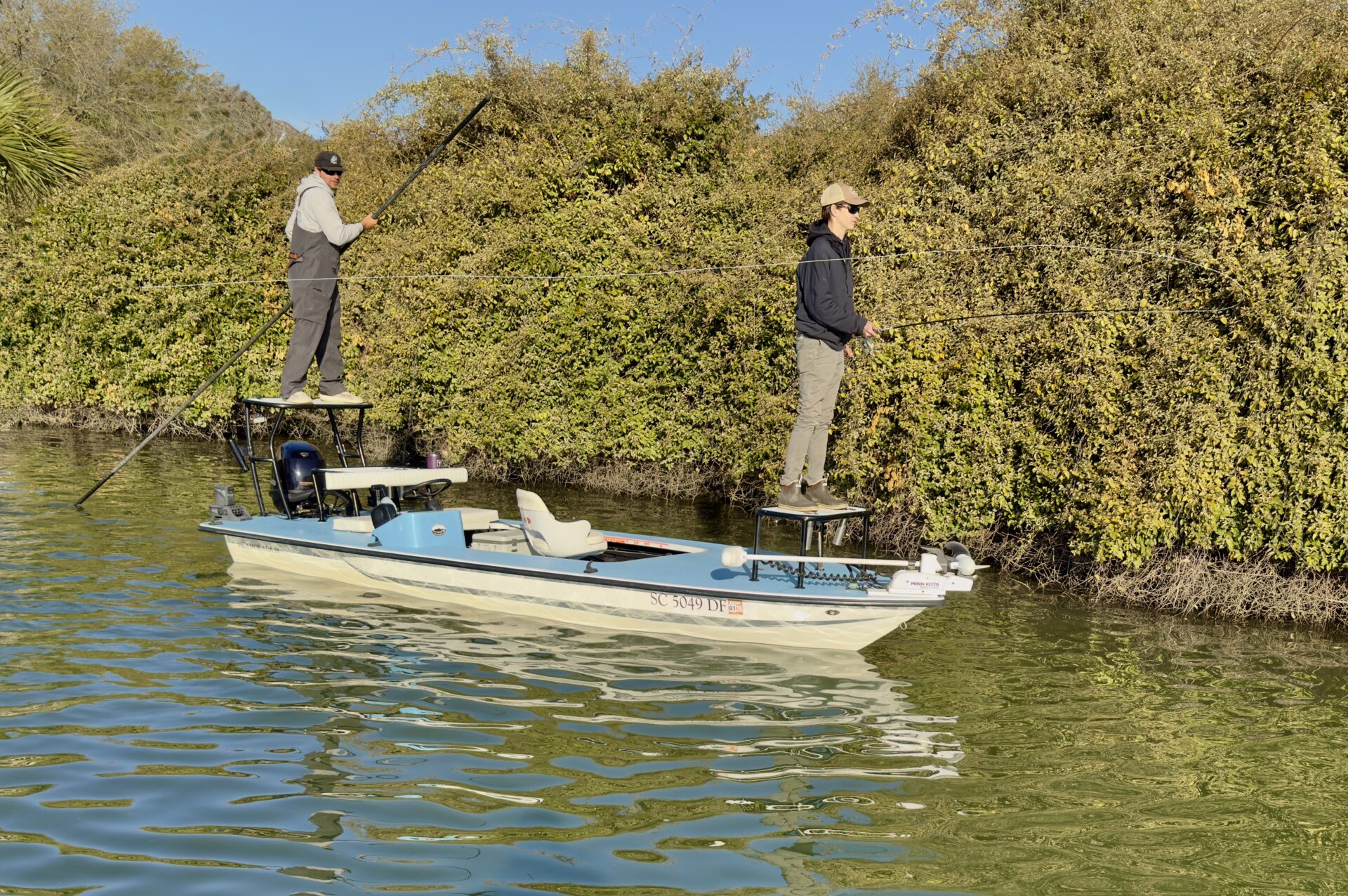Last Updated on August 7, 2025 by Eric Bonneman
As the long days of summer fade into the cooler, more temperate months of fall, the inshore waters off South Carolina begin to shift. Water temperatures drop, baitfish move, and several predatory species change their behavior in ways that make this time of year highly productive for fishermen. From the tidal creeks and marshes of the Lowcountry to the deeper flats near Charleston and up through the Grand Strand, opportunities are everywhere once the summer crowds clear out.
Changing Conditions After Summer
The most immediate shift following the end of summer is the cooling of surface water temperatures. While this begins slowly in early September, the pace quickens through October, particularly during mornings and evenings. Fish activity rises noticeably during this period. Species that stayed tucked deep in cooler water during July and August now feed more consistently in accessible areas.
There is also less boat traffic. With schools back in session and fewer visitors on the water, pressure drops, giving resident species more time to resume natural feeding patterns. For those willing to fish the edges, creeks, oyster beds, and flats with patience and intention, the results are often rewarding.
Where to Focus Inshore
- Tidal Creeks and Estuaries: These produce well on moving tides as shrimp and baitfish get pulled out with the current.
- Grass Lines and Marsh Points: Redfish commonly work the edge of marsh grass during higher tides.
- Mud Flats and Oyster Beds: Flounder and sheepshead gather in spots where structure meets soft bottom.
- Dock Pilings and Bridges: These hold sheepshead and black drum, especially in fall when crustacean activity increases.
Inshore Species to Target After Summer
Redfish (Red Drum)
Redfish remain a staple in South Carolina waters throughout the year, but fall marks one of the best times to pursue them. As baitfish like mullet and shrimp become more active, redfish begin to form larger schools and feed more aggressively.
This is an ideal season for sight fishing in skinny water. Techniques such as gold spoons, live shrimp under popping corks, and soft plastic jerkbaits along oyster bars produce steady results. Redfish tailing in grass during flood tides or pushing across mud flats on a dropping tide are common sights.

Speckled Sea Trout
Trout action builds steadily once water temperatures fall below 75 degrees. These fish gravitate toward deeper bends in creeks, submerged grass lines, and current seams where bait congregates.
Paddle-tail swimbaits on jigheads and live shrimp under corks are among the most effective methods. Look for productive windows around moving tides and plan for early morning or late afternoon sessions, particularly near creek mouths and grass points.
Flounder
The popular flatfish remain active into early fall and offer consistent action before cooling waters push them deeper. Flounder concentrate near creek mouths, channel edges, and sandy areas with structure.
Effective strategies include bouncing mud minnows or finger mullet along the bottom or using artificial flukes on jigheads. Areas where current meets cover are usually the most reliable.
Sheepshead
The sheepshead bite strengthens throughout the fall. These fish rely heavily on barnacles, crabs, and shrimp found around rocks, pilings, and oyster bars.
They require a more delicate presentation and steady hand. Light fluorocarbon leaders, small hooks, and natural bait like fiddler crabs or live shrimp work best when fishing tight to vertical structure.
Black Drum
Smaller black drum feed consistently through the fall and can often be caught in the same areas as redfish. They prefer bottom presentations with natural bait.
Cut crab, shrimp, or clam on a Carolina rig draws strikes. These fish don’t fight as explosively as redfish but are dependable and respond well to a quiet approach in areas with softer bottom.
Jack Crevalle
Jack crevalle may thin out later in the fall, but early in the season they still make aggressive appearances in tidal rivers and larger estuaries. When they show, the bite is immediate and intense.
Look for signs such as bait getting busted on the surface or birds diving over a school. Large swimbaits or topwater plugs can provoke vicious hits, and the fight is among the strongest you’ll experience on inshore gear.
Bluefish
Smaller bluefish remain active in tidal rips, deeper creeks, and around current seams. Their aggression makes them easy to catch on spoons, jigs, or plugs.
Although not often targeted directly, they are a frequent catch while fishing for trout or jacks and bring energy to slower stretches of the day.

Ladyfish
Ladyfish persist through the early fall and can be found chasing bait along the flats or around creek mouths. These fish are known for their speed and aerial displays.
They respond well to small jigs, spinners, and topwater plugs. Though not prized for eating, they are an excellent option for fast action and provide a fun challenge on light tackle.
Baitfish and Forage Movements
Fall signals the start of mullet migration, which sparks aggressive feeding behavior across many predator species. Shrimp also move more freely on strong tides during this time, especially during morning and evening.
Paying close attention to these forage shifts improves success. Slicks, diving birds, or schools of baitfish jumping at the surface all signal predator activity nearby.
Seasonal Strategy Considerations
- Tide Timing: Focus on mid-rise and mid-fall tides rather than slack water. These windows concentrate fish in predictable feeding zones.
- Wind and Water Clarity: Strong winds, especially from the east or south, can muddy inshore waters. Seek protected areas when visibility declines.
- Temperature Swings: Sudden cold fronts can temporarily slow the bite. Allow a day or two for fish to stabilize before resuming a steady pattern.
Why Fall Fishing in South Carolina Deserves Attention
By late September, most of the top inshore species become increasingly aggressive as they prepare for cooler months. These fish feed consistently and are easier to locate thanks to changing bait patterns and reduced traffic on the water.
The variety available this time of year sets the region apart. It’s common to spend a single outing catching trout, redfish, flounder, and jacks in a variety of conditions, all within sight of the same marsh system. Milder temperatures and less competition make each trip more enjoyable, especially for those willing to adapt to the seasonal shifts.
With a basic understanding of local tides, forage movement, and fish behavior, fall inshore fishing along the South Carolina coast can deliver reliable action from the back creeks to the main channels. This post-summer window is one of the best-kept secrets for fishermen who want action, variety, and quality in every session.
Why Fall Fishing in South Carolina Deserves Attention
By late September, most of the top inshore species become increasingly aggressive as they prepare for cooler months. These fish feed consistently and are easier to locate thanks to changing bait patterns and reduced traffic on the water. For many local fishermen, this post-summer window rivals the height of spring in both quality and reliability.
The variety available this time of year sets the region apart. It’s common to spend a single outing catching trout, redfish, flounder, and jacks in a range of environments, all within the same marsh system. You might also encounter bluefish, ladyfish, or even the occasional juvenile tarpon or tripletail in the southern estuaries when conditions hold warm enough. These rarer sightings bring unexpected excitement and round out an already strong fall fishery.
Milder temperatures and quieter waterways make each outing more enjoyable, especially for those who adjust tactics to match seasonal changes. Shifts in bait movement, tidal flow, and wind direction influence every creek bend and flat, and this time of year rewards those who fish with attention to detail. Even familiar water behaves differently once fall takes hold.
At Carolina Guide Service, we cover this window closely and understand the patterns that define it. Based in Pawleys Island and run by Captain Jordan Pate, our charter service provides direct access to South Carolina’s most productive inshore fisheries. If you’re ready to take advantage of the fall bite, book a trip with us and experience what makes this season so rewarding.
